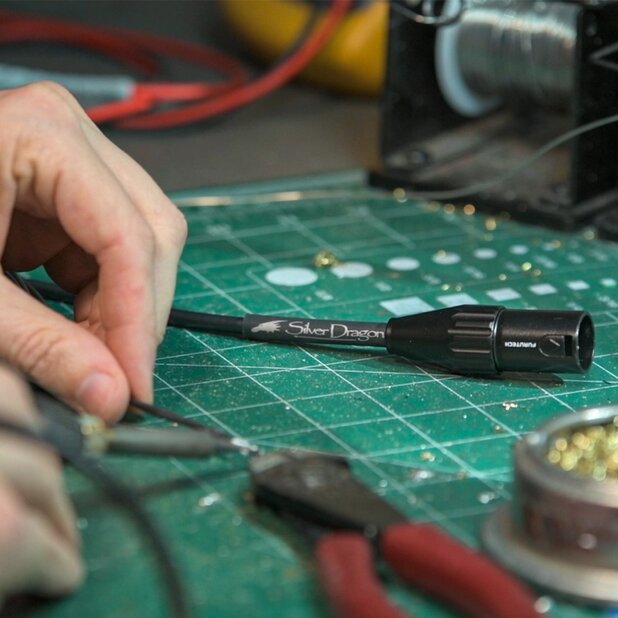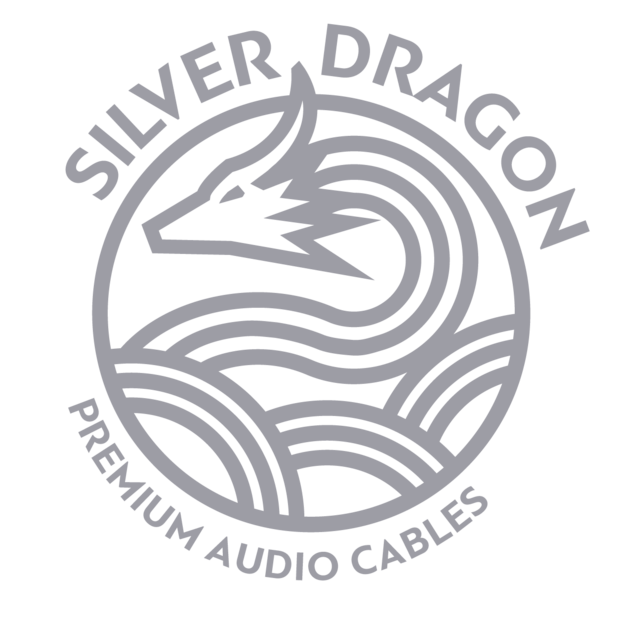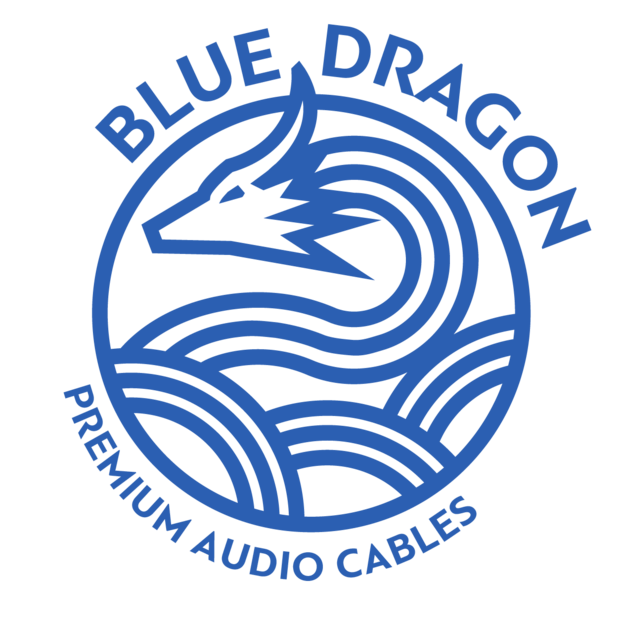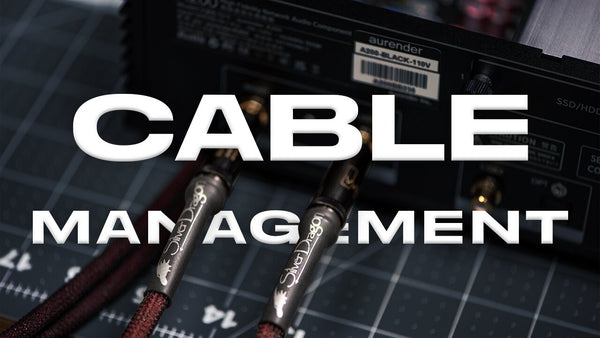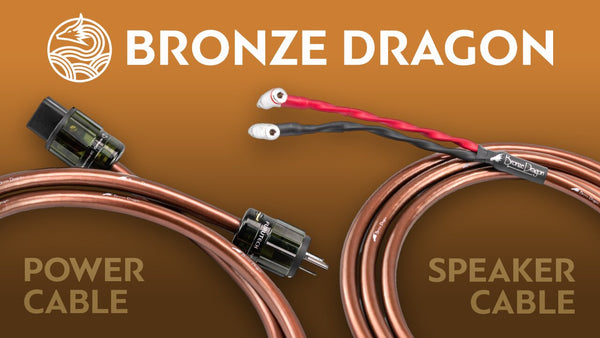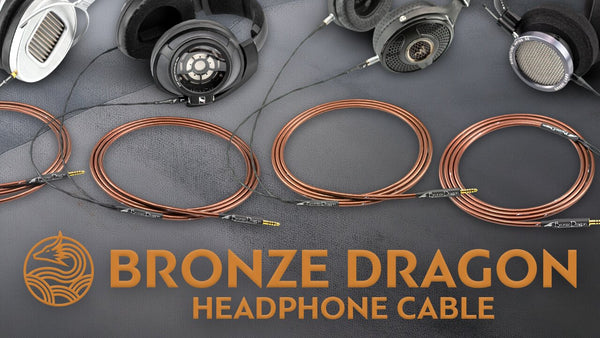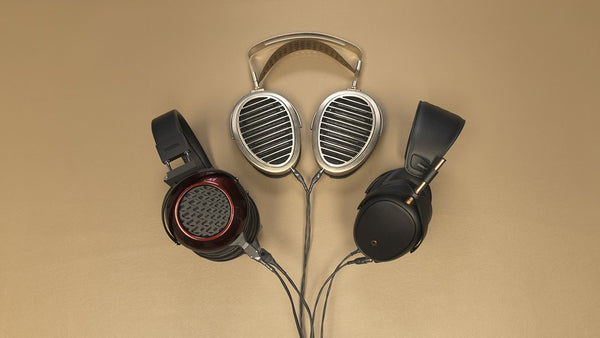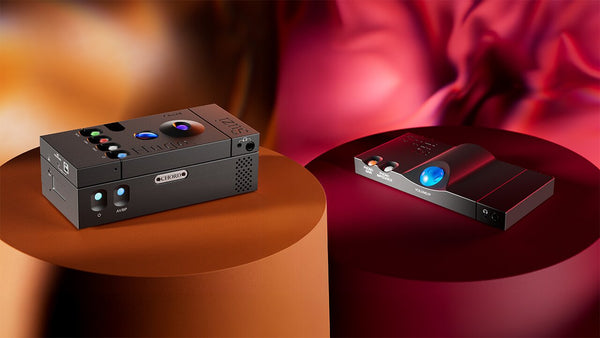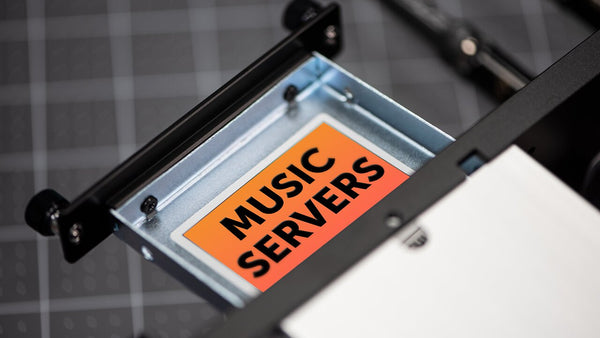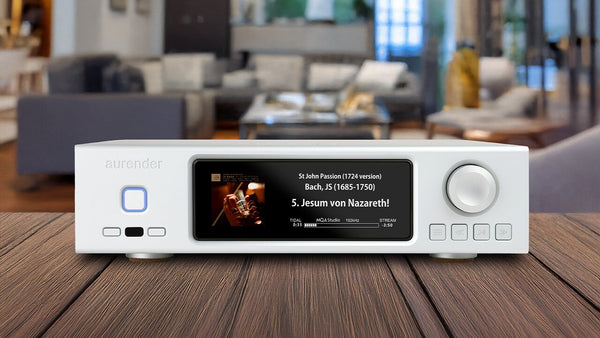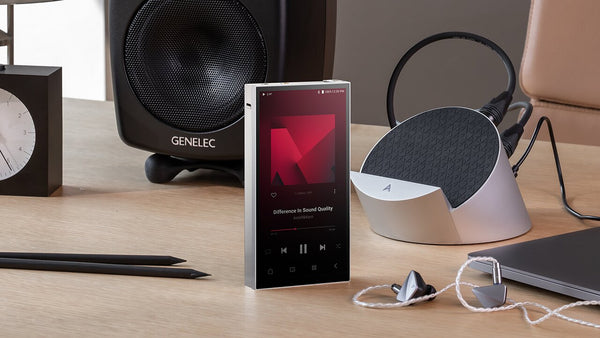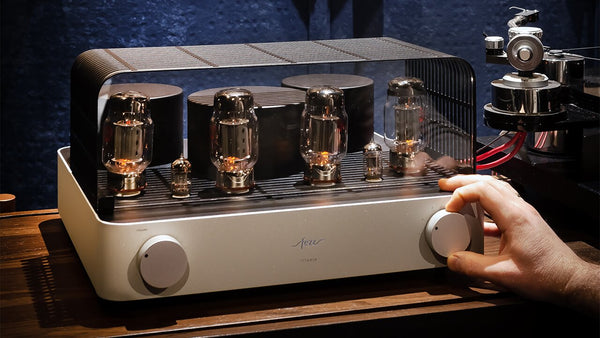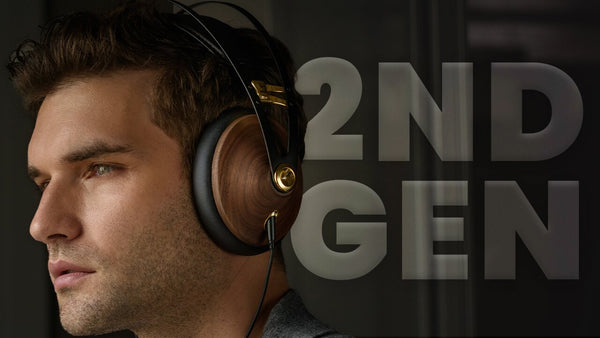The Science of Audio Cables
Read Time: Approx. 28 min.

The Weakest Link: Why Stock Cables Hold Back Your Audio
You’ve heard the saying that a chain is only as strong as its weakest link, right? Well the same applies to your brand-new audiophile-grade headphone or other audio components. The weakest link in this case is your stock cable or the stock interconnects the manufacturer threw in the box just to connect your audio components. Why is it the weakest link? There are many reasons, but foremost is that your stock cable isn’t manufactured in the same way your high-end product is that it accompanies. Your audiophile-grade gear has been tested, manufactured, milled to precision, and finely tuned, all while using the best materials and consideration. Unfortunately, the same cannot be said for your stock cables.They are often mass produced, spec'd specifically for the product, and not quality controlled in the slightest. I might be a little harsh here, but the fact remains that the same care and consideration for your product is not mirrored in the accessories, especially the stock cable.
Most of the time, companies skimp on the audio cables included with their headphones or audio components because its an afterthought or an ends to a means. They put their R&D into the driver for the headphones and rightly so, as it makes the most difference in the sound quality of the headphones. However, they use poor materials in the cable that connects the headphones to your music source which creates a bottleneck in the sound or a curtain or veil in front of your music. Audio cables are more reliable than wireless connections, capable of transmitting the highest audio resolutions, and they are the easiest way of setting up your audio system. They are critical, and yet they are often an afterthought. Why do companies skimp on cheap materials and connectors? Because customers are buying the product, not the cable. We’ll learn more about this later in the article.
The other thing to consider when questioning if cables make a difference in audio quality is that everyone hears differently.
Why We Hear Differently
We all have a friend who hates the music we love. Rap versus country, rock versus metal, polka versus a cappella indie experimental death folk – there’s always a yin to the yang. But why the difference?
Without getting too philosophical and talking about how your musical preferences come down to your cultural upbringing and life experiences, we can at least discuss one thing that truly sets us apart. The “experience” of listening to music in actuality has much do with how we physically “hear” sounds. Particularly, when the inner ear receives sound, it triggers a reaction from the different brain cells that are responsible for transmitting the information to your brain. That triggering forms different patterns that, in turn, touch different parts of the brain, explaining why we associate certain sounds with certain memories and feelings.

However, that might not be the case with everyone, as we are all wired differently too. The science is still new, but everyone agrees that we experience and perceive sound differently on a physiological level. Many things can be attributed to this, especially age, gender and other various personal demographics.
The Perception of Sound
Have you ever heard your voice on a recording and thought, “That doesn’t sound like me!” You spend your entire life hearing the sound produced by your vocal cords being inducted through your bones to your eardrums, rather than as a sound wave being transmitted through the air in the way we hear other voices. Thus, you have developed a perception of what you think your voice sounds like to others when in fact, it sounds quite different. That is why most people have an aversion to hearing themselves recorded, not because they dislike the quality of their voice, but because we perceive our voice to be different from what it actually sounds like.
I’m sure most of us remember the Yanny/Laurel phenomena that hit the internet a few years ago, but this just further drives the point home. It’s a single sound clip, but two people can be hearing completely differently things based on which frequency response they are focusing on (or hear since higher frequencies are often the first to go with hearing loss). The auditory version of the “White Dress” viral image, Yanny/Laurel helps us to easily perceive how we can hear completely different things from one another.

The same can be said for our senses. No one smells, sees, tastes and feels the same way either (e.g. the White Dress viral image). Yet, there are common properties that make things appealing to the masses, like pizza, roses, and puppies. If you don’t like puppies then you’re not human. It’s simple science (joking). The same goes for sound. It’s not something that is easily explained outside of physiological differences, but it exists.
Is Soundstage Tied to Frequency Response? Soundstage in Headphones Explained
Measuring the Immeasurable
How do you quantify or qualify something that cannot be measured? No one argues that music makes us feel good. It can affect our mood for better or worse and heightens our senses. The argument that “it exists” is not entirely convincing or satisfactory.
The fact remains, however, from the very physiological responses our body makes while listening to music. The reaction is itself proof that something is happening. The excitement and adrenaline rush when you hear the finale of your favorite symphony, the longing and emotion that is fueled from a sad song, or the thrill of yelling your favorite song with your friends as you drive down the road; music is the catalyst for these emotions.


The only thing we really know is that music affects our brain in such a way to cause these reactions and emotions. We can only measure them by observing a response when “interacting or listening to music” and that they stimulate our brain in such a way to create a physiological reaction.
How music makes you feel can be as varied a response as the number of music genres in the world. It can also depend on several variables, the least of these being your current mood. Music not only speaks to people differently, but also at different times. I can’t tell you the number of times I get goosebumps listening to a song, want to listen to it again, and it’s great – but it just doesn’t have the same impact as it did the first time listening to it. Months later I'll listen to it with some rested ears and there it is again – the goosebumps.
It's difficult to measure emotions apart from observing neuron activity and other physiological reactions, unfortunately the fact that we all hear and experience music differently only exacerbates finding a solution to the question if audio cables make a difference. If there is such a strong subjective component to this debacle, is there anything objective we can study?
Blinding Me with Science: What We Can Measure
So, if everyone hears differently, how do you establish a control when trying to compare audio quality A versus audio quality B?
In the case of audio cables, one thing that we can qualitatively measure regarding audio quality are the materials that the cables are made from. Materials matter, and just like cables, and not all materials are made with the same quality, care, and consideration.
There is a general rule of thumb for technology: you get what you pay for (although there are always exceptions to the rule).
Audio cables are composed of various materials, but the ones we’ll be concerned with primarily are copper and silver. The copper and silver strands are the core of the cable, transmitting the audio signal from one end to the other. Why copper and silver?
Copper is an incredibly conductive material, used in both audio transmission and heat dissipation/thermal applications. The reason that copper is the most widely used material for speaker cables and headphone cables is due to its low cost and low resistance. Audio-grade copper will be much different than commercial-grade, as Cardas points out, “What we had discovered in commercial copper was a severe shredding of the crystalline structure. Basically, charges and heat flow are scattered by impurities, imperfections and inhomogeneous metal structure.”
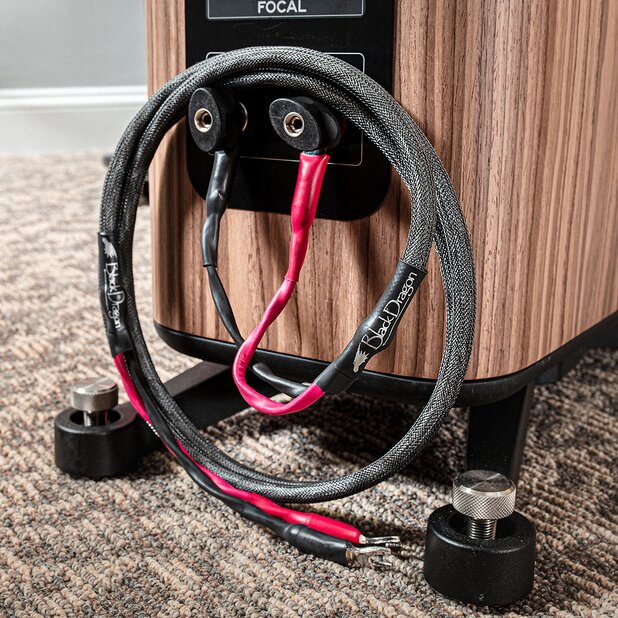
In other words, quality control. Most copper is formed from crystals; each of these crystals are contained in many small regions called grains and in between the grains are boundaries. * The electricity must pass through these boundaries, but depending on how the copper is manufactured, these grains and boundaries can worsen and become more numerous. Copper tends to sound warmer and gives more “body” to music, but it is slower and less harmonically rich than silver. Silver sounds lively, while offering more clarity and harmonic richness to your music. The downside to silver is that depending on the genre, it can create a cold characteristic to the audio, making it sound thinner and harsher in higher frequencies in worst case scenarios.
Audio cables should be made from pure materials; impure materials can introduce “nonlinearities” (the oxidized copper can behave as a semiconductor) that can develop as increased distortion at low signal levels. Distortion ultimately takes away from the clarity of the signal, depending on the level of the signal. The purer the material, the less artifacts will be introduced into the audio signal. Now some people might argue that cable impurities will not cause any audible difference to the human ear; you’ll hear stories online of people using an actual coat hanger as an audio cable without any noticeable difference. I hate to say it, if you can’t hear the difference between a coat hanger and a high-end cable, then your entire sound system isn’t serving your music justice.
The general rule of thumb is the better quality the cable = the less impurities in the materials
The same can be said about silver. Silver is more conductive and more expensive to produce than copper. The conductive properties of both materials are easy to measure. However, what does conductivity have to do with audio signals? The better the conductive properties of a metal equates to the less of of current or signal. So, the more conductive the metal is, the more suitable it is for audio applications.
Of course, there are so many other factors that affect the sound signatures of both copper and silver that include:
- Age of material
- Insulation
- Oxidization
- Conductor geometry
- Purity
- Direction
- Treatment
- Temperature
- Etc…
Oxidization
The process of oxidation diminishes conductivity, which is why “purer” materials are not oxidized. Copper oxidizes rapidly, which is why they are often coated to prevent or slow down the process to main its conductivity over time.
Gold is less conductive than copper, by an estimated 40%. However, cables with end terminals that are coated in gold will retain their conductivity over time since gold does not oxidize. Rhodium plated ends are only half as conductive as gold and even a third of silver’s conductivity but is immune to corrosion and oxidation. Nickel, bronze, brass and other materials also have varying conductivity compared to copper, but can oxidize at different rates, resulting in varying performance to that of copper at varying oxidation levels. For instance, a gold end terminal might be less conductive, but it will be superior to a highly oxidized copper terminal. Purity is key.
Oxidization affects sound. Also note that oxidization is not to be confused with the process of manufacturing for the strands themselves. We'll discuss the differences between UFC and OCC processes later.
Components
Conductors–Are More Conductors Better?
A conductor is just the material used that transport the electrical current or audio from the source to its load. For the sake of cables, we’ll be discussing silver and copper since they are the most used and common conductors within audio cables.
To make it simple, more is not necessarily better. It really depends on the application. The most common wire used in construction use 3 conductors: hot, neutral and ground. However, cables today can be manufactured to range from 1 to hundreds of conductors. We use four conductors in our Silver Dragon Headphone Cables and Black Dragon Headphone Cables and eight in our Bronze Dragon IEM Cable and portable headphone cables for reference.
As we will see later, it’s not so much the quantity as it is the quality of the conductors that really make the most difference in the fidelity of your music.
- Impedance
- Capacitance
- Inductance
- Resistance
Is there any difference in the sound between balanced and unbalanced or single-ended audio?
Sound Signatures
Every headphone, cable, and music player have their own intrinsic sound qualities. Some emphasize the higher treble ranges while others strengthen the bass frequencies. This overall sound profile is called a sound signature and understanding the basic categories will help you pair your cables and devices to fine-tune your listening experience.
Sound Signatures describe how high and low sounds are emphasized (or not emphasized). The range from highs to lows includes: Bright, Analytical, Neutral, Warm, and Dark. V-shaped has lower mid frequencies.
The frequency spectrum helps to determine the sound signature. Different levels in sound in Hertz, or Hz, are measured on a spectrum and the properties of the materials in the cable and/or headphones can influence the frequency response of your music.
Let’s look at some graphs to better understand how this is visualized.
Neutral

A neutral sound signature is just how you would imagine. Frequencies are not emphasized in any range, and the sound is reproduced as faithfully as possible. Reference headphones are tuned for a neutral sound signature, making them an ideal choice for mastering and studio work. Neutral signatures do not add any coloration to the audio, leaving the music as it was recorded. You may also hear this described as balanced or flat, though there are subtle differences.
Analytical

Analytical sound signatures are still very neutral and balanced but have a slight emphasis on the higher treble range. Details in instrumentation are a little clearer and more complex. Beryllium drivers and silver conductors lean toward more analytical sound signatures.
Bright

Bright audio boosts the higher ranges even more. While some may enjoy the sharpened treble, the human ear is more sensitive to these higher audio frequencies and long listening sessions quickly lead to fatigue. You may also hear this described as forward-sounding, but it’s typically less extreme.
Dark

Dark sound signatures give a bigger boost to the bottom end frequencies. Lows and rich and intricate but highs sound recessed and rolled off, as if hidden. Like bright sound signatures, dark audio is a bit too extreme for most listeners.
Warm

The counterpart to analytical, warm signatures apply a slight boost to the lower audio ranges. Bottom-end instruments like the bass guitar and cello sound more expansive with added depth, making it a good fit for rock and blues. Copper conductors lend themselves to a warmer sound signature. You may also hear this described as smooth or musical.
V-Shaped

V-shaped sound signatures give a slight boost to both the upper and lower frequencies, leaving a slight dip in the mid-range. This signature makes the audio sound louder and reduces ambient noise, which can make it sound a bit unnatural. Nevertheless, the coloration makes it naturally appealing to the human ear. You may also hear this described as U-shaped when the mid-range dip is less pronounced.
Headphone Sound Signatures: How to Identify What You Prefer
Sound Signatures in the Wild
Every piece of gear in your sound system has a sound signature. Your DAC, the amplifier, your pair of speakers or headphones; they all have their own material properties that can affect the coloration or resonance of your music, altering the way it sounds from the original. Although it’s not necessarily a bad thing, the trick is choosing gear that is going to best match the type of music you listen to.
“What kind of music do you listen to?”
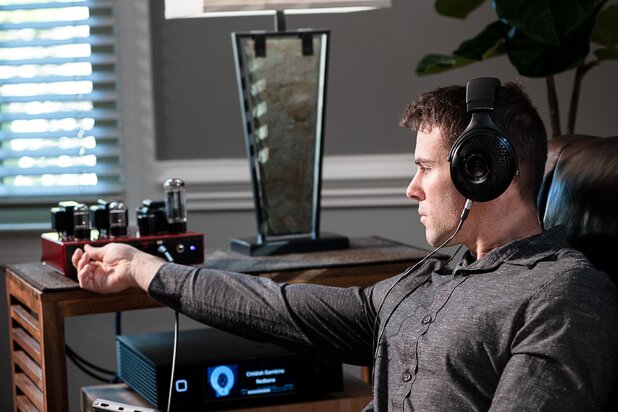
The variations are endless: Beryllium drivers are forward sounding, planar magnetic drivers tend to sound more resolute than neodymium cone drivers, often resulting in a dip in lower frequencies by comparison, open back headphones have a larger soundstage than closed back headphones, tube is going to sound warmer than solid state, and on and on. Even to the experienced ear, pairing your gear by sound signature can be tricky unless you know what to listen for.
Usually the output is the most important part in influencing the sound signature of your music, being speakers and headphones. What most people don’t realize is that the materials in cables can bring out the best or the worst of your sound output, depending on how they are matched.
Handcrafted Audio Cables: The Art & Science of Dragon Cables
The Dragon Cable Experience. What does that even mean? I’m going to try my best to give you the facts and not sugar coat you with tales of fidelity fairy dust.
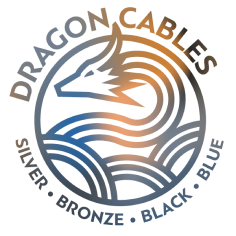
At Moon Audio, we use the best raw materials in our cables to unveil your music. We believe that the materials matter. Your cable should have the same care and craftsmanship that manufacturers put into their audio cables. Why is the cable always an afterthought, when it’s just as important as the rest of your system? It is ultimately the connection to your music. The fact remains that cabling is often considered the last priority to that of the main product and a means to cut down the overall production costs. It’s as simple as that.
Generally, stock cables are manufactured with subpar materials, metals with impurities, poor geometries, and an overabundance of layers to make them look and feel like a fire hose. Inconsistency and lack of quality control in stock cables can lead to poor sound quality and a veiled sound vs what the musician intended for you to hear and feel from the music. Dragon Cables are handcrafted daily by our engineers in Cary, NC to the highest standards and made to order according to your specific connection .
At Moon Audio, we create a custom cable for you using the highest quality UP-OCC silver or copper conductors that can be manufactured. We have one of the largest collections of connection options available and we can create hundreds of combinations depending on your specific gear and needs.
The Dragon Cable Experience: Why Audio Cables Matter
UP-OCC: What Is it?
We use what is called UP-OCC. This stands for Ultra Pure Ohno Continuos casting. This is a process developed by Dr. Ohno of Japan. Conventional methods of extruding copper results in multiple and fractionated crystalline structure. Oxygen Free Copper (OFC) has a distinctive effect on your audio quality that some might find lacking. The OCC process uses a heated mold for extruding, whereas other processes involve a cooled mold. The cooling process in OCC takes place separately, resulting in larger crystal sizes and increased purity. So, from a materials perspective, the OCC process is far superior to OFC.
Correcting Bad Sound
Materials matter. Remember that? Copper and Silver conductors can craft the signature and affect the overall tone of your music. If your headphones are too forward sounding for the kind of music you like to listen to, don’t worry – pairing them with a Black Dragon Headphone Cable will bring out more warmth and create a music presentation which should counter-balance the troublesome higher frequencies of your headphones.
On the other side, if your headphones are very warm sounding, then pairing them with a Silver Dragon Headphone Cable will bring out more details and tighten up the lower frequency ranges. There is always a perfect cable pairing depending on what you want out of your gear or music.
Moon Audio Connectors–A Connector for Every Need

One thing that sets Moon Audio apart from other cable manufacturers is that we create custom solutions for you. Our office is stocked with hundreds of high-quality connectors that are available by custom order. Most cable manufacturers have their set generic connection types and lengths, without giving the consumer the option of customizing it for their specific gear. Moon Audio cables are custom ordered and hand made to your exact specifications, providing a cable tailored to your audio system.
Need a custom cable solution? Look no further. Please Contact Us with your cable needs!
The Dragon Cable Experience: Headphone Cables
Silver Dragon
Made up of 4 x 99.99998% UP-OCC stranded silver 24AWG Teflon insulated stranded conductors, our Silver Dragon conductors are free from impurities and have virtually no crystal boundaries. Silver is the most efficient electrical conductor with less resistance than other metals used in cables, like gold, zinc, and aluminum. The Silver Dragon Universal Headphone Cable can improve the listening enjoyment of most high-end headphones and it has lots of details, great energy, a fantastic soundstage with lots of air.
High-purity silver conductors provide the most detailed and resolute sound signal possible. The sound signature of the Silver Dragon is detailed an analytical; instrumentation is clear and distinct, especially in the treble ranges. Bass frequencies are tighter and more controlled. It is a great candidate for darker sounding headphones or headphones that have a bloated bottom end.
For example, headphones such as the Sennheiser HD650 (a darker/warmer sounding can) or headphones like the Hifiman HE-500 and the Audeze LCD-2 & LCD-3, which are planar magnetic driver headphones and warmer sounding headphones. The Silver Dragon Universal Headphone Cable will add detail and clarity to the top end and provide a cleaner more transparent sound. With closed headphones such as the Denon AH-D7200 & AH-D5200 the Silver Dragon will tighten up the bottom end and control the bass better.
The Silver Dragon Universal Headphone Cable is not a good choice for a thin-sounding headphone like the AKG K701. Nor is it a good choice for a forward sounding headphone such as the Grado RS-1, which is very much like a studio monitor or an up close and personal sound. However, there are still folks out there that are detail freaks and want to push or tip things more forward so we have actually re-cabled both of these examples with the Silver Dragon Headphone Cable. As Drew explains, it just depends on what you are trying to do and your affinity for sound. Lastly, the Silver Dragon Headphone Cable is also a good choice for a phone that has a bloated bottom end like the Ultrasone Pro 900. It will tighten up the bass and make it more defined.
After much research and development, we've improved the Silver Dragon conductor's properties, as these conductors are free from impurities and have virtually no crystal boundaries. The conductors have almost no distortion compared to ordinary silver conductors. Each conductor is made up of a special, varying-sized stranded geometry. The silver strandings are mixed with Kevlar standing's to reinforce the conductor making it stronger overall and less prone to failure due to the harsh constant flexing that headphone cables experience.
Each conductor is encapsulated in a Teflon casing. The conductors are then surrounded by cotton and a thin layer of aluminum foil. It is then protected by a 100% coverage silver plated copper secondary shield and placed in a polyethylene jacket for further protection. To improve its flexibility, we are no longer using a Techflex jacketing as we did with our previous versions.
A variety of connection options are available for your downstream connection such as the mini plug, RCA, XLR and a whole host of others. We custom build these in house to your connection specifications. The cable can be used in either a single-ended or balanced design. The wire is soldered to a connector using high-quality Cardas silver solder.
Pairs well with:
- Audeze LCD-2 Headphones
- Audeze LCD-3 Headphones
- HiFiMan HE-500 Headphones
- Sennheiser HD 650 Headphones
- Dan Clark Audio ETHER 2 Headphones
Black Dragon
The magic behind our Black Dragon Headphone Cable lies in its construction. We use 4 x 21.5AWG Teflon-insulated stranded conductors using pure single crystallized UP-OCC pure copper with 7N purity 99.99998%. This means more music, clarity and sound quality gets to your ears as purity in cable construction, cable design and quality of materials make a noticeable difference in the sound quality of your headphones.
Each conductor is made up of a special varying size stranding geometry. The copper stranding is mixed with Kevlar stranding to reinforce the conductor. Making it stronger overall and less prone to failure due to the harsh constant flexing a headphone cable receives.
The conductors are then surrounded by cotton and then a layer of Teflon tubing. The new v2 version is now also double shielded and placed in a polyethylene jacket for further protection.
The Headphone connectors are soldered directly to the conductors of the cable. The splicing method used by other cable companies using a stock cable's connectors is a poor method. We have developed many of the hard to find connection options utilizing plastic injection molded connectors. Great expense has been taken to bring as many hard to find connection systems for the most popular headphones. If you can't find the connection system you desire please contact us.
The wire is soldered to the connector with Cardas silver solder. The overall quality of the materials used for the Black Dragon cables translates to durability and making sure your cable can perform at peak performance for longer than other, less efficient stock cables.
The Black Dragon is warm and smooth with a musical presentation. Copper strands enhance the body, shape, and immediacy of the music. The detail and expansiveness of the Black Dragon make it a flexible fit where a broad range of musical genres are played. It can also improve bass frequencies on bass-light headphones.
The smooth, musical quality makes it a perfect fit for headphones that tend to sound a bit edgy or bright. Despite its warmth, the Black Dragon does not have a laid back, lush sound. It is much closer to a neutral sound signature, making it a very natural sounding cable.
Pairs well with:
- Focal Utopia Headphones
- Focal Stellia Headphones
- Sennheiser HD 800S Headphones
Bronze Dragon
The Bronze Dragon Universal Headphone Cable is dynamic and musical, delivering an incredibly tight and controlled sound quality with a powerful bass response to your favorite headphones. The Bronze Dragon Headphone Cable is a culmination of 20 years of Moon Audio's desire to exceed the price-performance ratio, and a testament to our never-ending goal to continually produce HiFi Audio Cables that over-deliver on performance in the marketplace.
Pushing the boundaries of audio cable performance, the Bronze Dragon Headphone Cable uses a new process of adding Graphene to our UP-OCC copper strandings. Graphene is a single-atom-thick, 2-dimensional material composed of carbon atoms arranged in a hexagonal lattice geometry. This unique material is 200 times stronger than steel but incredibly flexible without added weight, providing a more efficient transmission of electrical signals. It adds strength, flexibility, and conductivity to the metal it is bound with. The base of the Bronze Dragon Headphone Cable is composed of OCC copper–single-crystal continuous cast copper, or Ohno Continuous Cast. OCC is a manufacturing process that prevents any crystalline fractures or minimal grain boundaries, which essentially become potholes that the electrical signal must bypass.
Pairs well with:
Designed for portable headphones, the Bronze Dragon Portable Headphone Cable features a single-entry design for use with Sony WH-1000XM3, Sennheiser Momentum, and similar headphones from manufacturers like Bose, Ultrasone, and AKG.
The Bronze Dragon helps create a warmer presentation with bigger and fuller body, adding bottom end strength and muscle. Our new Dragon cable is musical without becoming lush or bloated and features a flexible cable that's perfect for on-the-go applications.
With a warm presentation, Bronze Dragon strengthens the bottom end without becoming bloated. Bass guitar and cello are full and immersive, creating a musical that's not too lush. The warmth and fullness of the Bronze Dragon create the muscle needed to round out a flat signature.
Pairs well with:
- Sony WH-1000XM3 Headphones
- Sennheiser Momentum Headphones
Blue Dragon
The Blue Dragon Universal Headphone Cable is a neutral and natural sounding cable which is great for vocal performances.
It is a good fit if you want to improve clarity and dynamics in your headphones and do not want to add coloration. Furthermore, if you do not want to tip the headphone forward or back, then the Blue Dragon is a wonderful choice.
The Blue Dragon Headphone Cable has been designed to match the Silver Dragon headphone cable but with a high purity copper conductor using the Ohno Continuous Casting Process. The Blue Dragon has the same geometry structure as the Silver Dragon only it uses UP-OCC pure copper. It is also the best bang for the buck custom headphone cable on the market today.
Each conductor of the Blue Dragon is made up of a special varying size stranding geometry. The copper stranding is mixed with Kevlar stranding to reinforce the conductor. This makes it stronger overall and less prone to failure due to the harsh constant flexing a headphone cable receives. The conductors are then surrounded by cotton and then a layer of Teflon tape.
This most recent version is now also shielded and placed in a polyethylene jacket for further protection. The Blue Dragon is also quieter than the previous version with no microphonics.
The Blue Dragon is our value full size headphone cable. Using copper strands, it combines the neutrality of the Black Dragon with the clarity of the Silver Dragon at a lower price point. The Blue Dragon is a good fit for improving dynamics without adding coloration. Its calm and neutral sound make it a great place to start with premium cables.
For example, the Sennheiser HD600 has long been one of the best headphones for classical music on the high-end headphone market due to it's smooth, warm sound signature. The HD600 is not as dark and laid back as the Sennheiser HD650 and so the neutrality of the Blue Dragon Headphone Cable is the better fit for the HD600 signature. It is a great cable for a wide variety of music genres.
If you are using a very warm tube amp and a forward headphone, the Blue Dragon is also a good choice to keep the sound signature the same. The Blue Dragon is also the most flexible of the full-size headphone cables and makes a good choice for headphones that use a single entry connection point like many of the Ultrasone headphones.
This Blue Dragon headphone cable can be a replacement cable for Sennheiser HD800S, HD650, HD600 and HD580 headphones or any other Sennheiser headphones that have the 2-pin connection system.
We also modify it for Ultrasone, Sony, and any other headphone that uses a connector attachment system. This headphone cable can also be hardwired to Grado's, and Audio Technica headphones. If it can be done, Moon Audio can modify it!
Moon Audio also recently added specialized Blue Dragon cables for Shure full size headphone models and the Sennheiser HD700.
Pairs well with:
- Sennheiser HD 5, 6, 7, and 8 Series
- Dan Clark Audio E3 Headphones
- Dan Clark Audio Noire XO Headphones
How to Choose a Cable for Your Wired Headphones
Dragon Audio Cables: USB & Power Cables
USB Cables
In much the same way as the headphone cables, USB cables can adjust the sound signature of your digital music through USB audio transmission. Standard USB cables are not up to the task of large bit rate information. The materials of the Dragon USB Cables are designed to handle large capacity data transfers with ease, ensuring that every bit of your high-resolution audio is being delivered to your high-fidelity system.
The Dragon USB Cable comes in our Silver Dragon and Black Dragon variants. The sound signatures of each are similar to their headphone cable counterparts, and like them, can be customized with many different connection types according to your personalized needs.
USB Cables: How to Identify Which One You Need
Power Cables
Stock power cables can sometimes lack proper shielding leaving it exposed to outside interference in the signal, leaving your music to compete with external noise and other factors. Our Dragon Power Cables are available in the Blue Dragon, Black Dragon, and Bronze Dragon, each offering different options to match specific systems better.
Blue Dragon power Cable
The Blue Dragon Power Cable's geometry has been slightly altered from the previous iteration to add more flexibility. The outer jacket is much more pliable to make the dreaded IEC connection droop less of an issue and the overall outer diameter (OD) is around 11mm which was reduced from 12.5mm, to help with flexibility. The conductor size remains constant at around 12awg.
We have retained the UPOCC copper conductors. The Geometry has been slightly altered from the original blue dragon power cord to add more flexibility. The outer jacket is much more pliable to make the dreaded IEC connection droop less of an issue and the overall outer diameter (OD) is around 11mm which was reduced from 12.5mm, to help with flexibility. The conductor size remains constant at around 12awg.
We double shield the cable to ward off all outside interference. Shielding is paramount in power cables, not only to protect it but to eliminate the power lines from corrupting your line level interconnects in close proximity.
The cable can be covered with a layer of Techflex braiding for added wear protection and good looks. Contact us for this option. We will be offering the cable with either the Cardas Rhodium male and female connectors. The Cardas power connectors feature a copper base with a Rhodium over Silver plating. As an upgrade option, we will be offering the Furutech FI-28(R)Connectors. These utilize α (Alpha) pure-copper rhodium-plated conductors. For the Shuko EU or European connector option, we are utilizing the Furutech FI-E38 (R). Other country options are available via special request. Please contact us for pricing.
Black Dragon power Cable
In our Black Dragon Power Cable, we've developed and implemented new geometry to create a noise free environment. 4-11Awg Stranded high purity slow drawn Copper conductors are used per cable in a star Quad configuration. Each conductor is made up with a special selection of stranding sizes. 2 for the positive and 2 for the negative. this yields a 8awg total size per signal polarity All conductor are wrapped in Teflon tape which is the next best dielectric after Air. Teflon tape is a way to reduce the overall thickness of the casing to reduce the dielectric value. The 4 conductors are then twisted together and Teflon taped as well.
The cable has a single 100% coverage shield but can be doubled up for noisy environments plus it is relatively flexible. The cable is covered in 2 layers of Techflex braiding for added protection and good looks. The male outlet used is a Furutech FI-11M (gold) 15A/125V 3-PRONG PLUG Black plug that is Alpha Copper based with a 24 karat gold platting. The female IEC outlet is the Furutech FI-11(gold) 15A/125V 3-PRONG PLUG Black plug that is Alpha Copper based with a 24 karat gold platting.
The cable is dead quiet and rejects all EMI and RFI interference. The cable is good for 15 and 20amp rating. 20 Amp versions come with the Furutech FI-31M (gold) 20A/125V 3-PRONG PLUG Black plug that is Alpha Copper based with a 24 karat gold platting. We also stock Schuko and UK Furutech Plugs as well as an upgrade path to the Top Line Furutech Plugs.
Bronze Dragon power Cable
The Bronze Dragon Power Cable is a culmination of 20 years of Moon Audio's desire to exceed the price-performance ratio, and a testament to our never-ending goal to continually produce HiFi Audio Cables that over-deliver on performance in the marketplace. Pushing the boundaries of audio cable performance, the Bronze Dragon Power Cable uses a new process of adding Graphene to our UP-OCC copper strandings. Graphene is a single-atom-thick, 2-dimensional material composed of carbon atoms arranged in a hexagonal lattice geometry. This unique material is 200 times stronger than steel but incredibly flexible without added weight, providing a more efficient transmission of electrical signals. It adds strength, flexibility, and conductivity to the metal it is bound with.
The base of the Bronze Dragon Power Cable is composed of OCC copper–single-crystal continuous cast copper, or Ohno Continuous Cast. OCC is a manufacturing process that prevents any crystalline fractures or minimal grain boundaries, which essentially become potholes that the electrical signal must bypass. The copper used in the Bronze Dragon Power Cable is devoid of all possible impurities that can change the coloration of the sound. Knowing that all materials have different coloration and the key to keeping the tonality consistent or slightly changing the coloration is to omit other metals or add other metals to the conductor stand, Graphene was the perfect choice. This not only improved the UP-OCC material but also changed the tonality of our Dragon UP-OCC conductor, delivering increased dynamics with a very musical flavor to the sound.
Conclusion: Do Audio Cables Matter?
In short, yes. Materials matter. Better materials mean better performance and longer life. The higher quality materials used in premium cables are irrefutably better quality than the materials used in OEM cables. This can translate to a number of improvements, including better shielding, lower noise floor, natural dB boost, and overall improvement in clarity, soundstage and definition of audio. That's why our Dragon Audio Cables are the ultimate solution to any audio application error.
Moreover, that’s the crux of our argument here: do better cables result in better sound? Answer: Try it. Test it out. See what works for you. Everyone hears differently, and at the end of the day the goal should always be to strive for better audio quality for the music you love. If you have any questions about audio cables, please Contact Us and we’ll be happy to answer any questions you may have! Happy listening!
Related Videos
USB Audio Cables: Why They're Important
Dragon Headphone Cables 101
Dragon MMCX IEM Cables: Everything You Need to Know

